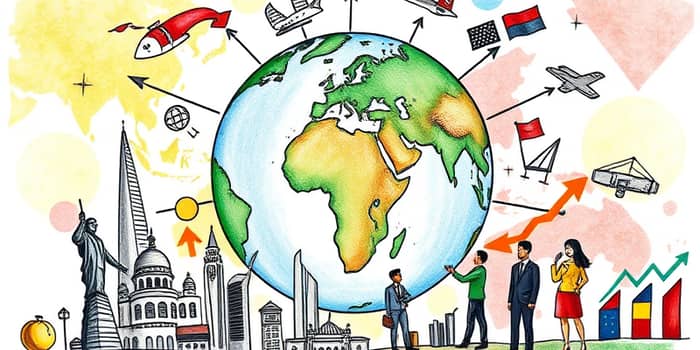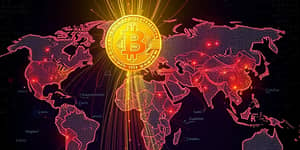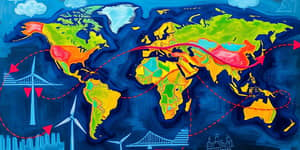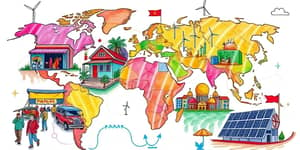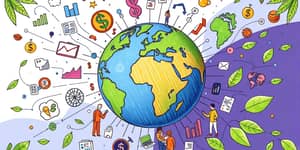In the wake of global uncertainties and rapid structural changes, the world stands at the threshold of a profound transformation. No longer dominated solely by Western powers, the global economy is evolving into a multipolar global economic landscape where emerging markets in Asia, Africa, and Latin America claim a central role.
This deep realignment—commonly termed economic rebalancing—reflects both the rise of new growth engines and the shifting priorities of established powers. As we navigate the remainder of 2025 and beyond, understanding these dynamics is essential for businesses, policymakers, and individuals seeking to thrive in an ever-changing environment.
Macroeconomic Outlook Through 2025
The global growth forecast for 2025 remains modest. According to UNCTAD, world GDP growth may slow to 2.3%, falling below the threshold typically associated with a global recession. The IMF offers a slightly more optimistic view, projecting 3.0% growth in 2025 and 3.1% in 2026—still hindered by ongoing trade tensions and policy uncertainties.
Inflation is expected to ease globally but will vary significantly by region. The IMF forecasts average inflation of 4.2% in 2025, edging down to 3.6% in 2026. Emerging markets in particular face vulnerability to cost and currency shocks, even as advanced economies experience divergent inflationary pressures.
Heightened policy uncertainty persists. The Economic Policy Uncertainty Index has soared to its highest level this century, while equity markets reflect elevated volatility, ranking only behind the peaks of 2020’s pandemic shock and the 2008 financial crisis.
Structural Shifts and the Rise of Multipolarity
The post–World War II Western-centric model is giving way to a world where power is dispersed. China and India, alongside other emerging economies, now account for the bulk of global population growth and investment activity. Their influence extends through trade, infrastructure financing, technology transfer, and geopolitical initiatives.
Beyond nation-states, nonstate actors—multinational corporations, tech giants, and regional blocs—shape policy debates and investment flows. This structural shift of economic power has fueled interest in alternative developmental frameworks, with the “China model” gaining traction in parts of Asia and Africa.
Meanwhile, advanced economies grapple with demographic headwinds. Europe and Japan face shrinking working-age populations, while the United States partially offsets this trend through higher birth rates and immigration. Migration pressures will intensify, as individuals seek opportunities in more dynamic regions.
Fractures in Globalization
After decades of deep integration, global trade is confronting new barriers. Geoeconomic fragmentation—a blend of deglobalization and selective engagement—is on the rise. Since early 2025, the United States has imposed steep tariffs: 50% on Brazilian imports, 35% on many Canadian goods, and 25% on selected Mexican products.
This protectionist turn has prompted businesses to reconfigure supply chains, front-load purchases, and explore alternative markets. As a result, traditional globalization is grinding to a halt, with policymakers shifting focus from monetary stimulus to fiscal and trade policy measures.
- Rising tariffs and quotas distort trade flows and raise input costs.
- Investments in regional supply corridors are accelerating in Asia, Africa, and Latin America.
- Technology decoupling amplifies uncertainty for global manufacturers.
Regional Spotlights
To grasp the contours of the new global order, we must examine key players.
- United States: Resilient consumer spending and corporate investment sustain growth, but tariff-driven inflation complicates monetary easing.
- China: Economic stimulus via rate cuts and fiscal expansion aims to stabilize short-term demand, even as global influence expands.
- India: Growth normalizes after rapid post-pandemic recovery, facing headwinds from domestic reforms and external pressures.
- Europe (Germany, EU): A €600 billion fiscal stimulus over five years signals a decisive shift away from austerity toward strategic investment in defense, technology, and infrastructure.
- Emerging Markets: Diverse policy responses range from rate cuts in Mexico and South Korea to tightening in Brazil and Turkey, reflecting local inflation and currency challenges.
Implications for Investors and Policymakers
As economic power rebalances, opportunities and risks emerge in equal measure. Investors can capitalize on faster-growing markets and sectors that align with new policy priorities—renewable energy in Asia, digital infrastructure in Africa, and advanced manufacturing in Eastern Europe.
Policymakers must bolster resilience by diversifying trade partnerships, investing in workforce skills, and strengthening social safety nets. A proactive stance on fiscal policy—rather than reliance on low interest rates alone—will be critical to sustaining growth in this uncertain landscape.
- Foster innovation ecosystems to capture gains from technological disruption.
- Pursue regional trade agreements to reduce exposure to tariff volatility.
- Implement targeted fiscal measures to support sectors hit by supply chain realignments.
Navigating Uncertainty and Building Resilience
Given the current high levels of policy uncertainty, businesses and governments must adopt agile strategies. Scenario planning—ranging from continued fragmentation to renewed cooperation—can guide long-term investments and risk mitigation.
Enhancing transparency and international dialogue remains vital. Even amid strategic competition, areas such as climate action, global health, and digital governance provide common ground for collaboration.
By embracing adaptive frameworks and nurturing inclusive growth, stakeholders can help shape a global order that balances multipolar interests with shared challenges.
Conclusion: Towards a Balanced Future
Economic rebalancing heralds a transformative era—one defined by dynamic shifts in global leadership and new models of development. While risks abound—from trade fragmentation to fiscal stress—the potential for broader prosperity is within reach.
Success in this new order depends on foresight, cooperation, and a willingness to innovate. By aligning policy, investment, and social goals, the world can chart a path toward a more balanced, resilient, and inclusive economic future.
References
- https://unctad.org/publication/trade-and-development-foresights-2025-under-pressure-uncertainty-reshapes-global
- https://www.oxfordeconomics.com/key-themes-2025/
- https://www.mckinsey.com/capabilities/strategy-and-corporate-finance/our-insights/global-economics-intelligence
- https://www.ey.com/en_us/insights/strategy/global-economic-outlook
- https://www.calamos.com/blogs/voices/2h-2025-global-outlook-a-great-global-rebalancing/
- https://www.alliancebernstein.com/corporate/en/insights/economic-perspectives/world-economy-to-continue-rebalancing-in-2025.html

